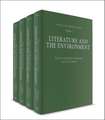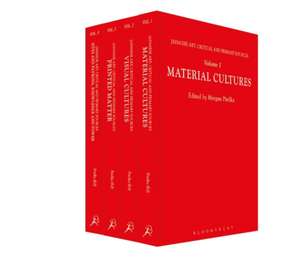Japanese Art: Critical and Primary Sources: Critical and Primary Sources
Editat de Morgan Pitelkaen Limba Engleză Quantity pack – 21 feb 2018
Din seria Critical and Primary Sources
- 30%
 Preț: 4450.14 lei
Preț: 4450.14 lei -
 Preț: 3406.98 lei
Preț: 3406.98 lei - 31%
 Preț: 4118.69 lei
Preț: 4118.69 lei - 14%
 Preț: 4150.79 lei
Preț: 4150.79 lei - 14%
 Preț: 4142.16 lei
Preț: 4142.16 lei - 14%
 Preț: 4393.92 lei
Preț: 4393.92 lei - 33%
 Preț: 4309.69 lei
Preț: 4309.69 lei - 33%
 Preț: 4285.73 lei
Preț: 4285.73 lei - 32%
 Preț: 4002.90 lei
Preț: 4002.90 lei - 31%
 Preț: 4121.69 lei
Preț: 4121.69 lei - 14%
 Preț: 4118.89 lei
Preț: 4118.89 lei - 34%
 Preț: 2970.44 lei
Preț: 2970.44 lei - 44%
 Preț: 3181.30 lei
Preț: 3181.30 lei - 31%
 Preț: 3545.81 lei
Preț: 3545.81 lei - 31%
 Preț: 2938.36 lei
Preț: 2938.36 lei - 31%
 Preț: 4123.73 lei
Preț: 4123.73 lei - 31%
 Preț: 4116.39 lei
Preț: 4116.39 lei - 37%
 Preț: 3542.53 lei
Preț: 3542.53 lei - 14%
 Preț: 3907.70 lei
Preț: 3907.70 lei - 14%
 Preț: 3907.26 lei
Preț: 3907.26 lei
Preț: 4443.54 lei
Preț vechi: 6184.29 lei
-28% Nou
Puncte Express: 6665
Preț estimativ în valută:
850.23€ • 887.81$ • 702.12£
850.23€ • 887.81$ • 702.12£
Carte disponibilă
Livrare economică 25 martie-08 aprilie
Preluare comenzi: 021 569.72.76
Specificații
ISBN-13: 9781350024502
ISBN-10: 1350024503
Greutate: 3.06 kg
Editura: Bloomsbury Publishing
Colecția Bloomsbury Academic
Seria Critical and Primary Sources
Locul publicării:London, United Kingdom
ISBN-10: 1350024503
Greutate: 3.06 kg
Editura: Bloomsbury Publishing
Colecția Bloomsbury Academic
Seria Critical and Primary Sources
Locul publicării:London, United Kingdom
Caracteristici
Features English-language essays exploring the material and visual cultures of Japan from a range of disciplines and countries.
Notă biografică
Morgan Pitelka is Professor of Asian Studies and Director of the Carolina Asia Center at the University of North Carolina at Chapel Hill, USA.
Cuprins
VOLUME 1: Material CulturesGeneral IntroductionIntroductionPart I: Buddhist Things1. The Buddha Triad Senbutsu unearthed in Japan: Replicating and Reinventing the Chinese Prototype in the Seventh Century, Yoko Hsueh Shirai2. Shifting Identities in Buddhist Sculpture: Who's Who in the Muroji Kondo, Sherry Fowler3. Containers of Sacred Text and Image at Twelfth-Century Choanji in Kyushu, Sherry Fowler4. Wooden Statues as Living Bodies: Deciphering the Meanings of the Deposits within Two Manjushri Images of the Saidaiji Order, Pei-Jung Wu5. Tokens of Faith: Japanese Altar Cloths of the Edo Period, Helen LovedayPart II: Ceramics6. Debating Jomon Social Complexity, Richard Pearson7. The Dogu Phenomenon, Nicole Coolidge Rousmaniere8. Tea Taste: Patronage and Collaboration Among Tea Masters and Potters in Early Modern Japan, Morgan Pitelka9. Modern Japanese Ceramics into Mingei: Art, Industry and Idea, Richard L. WilsonPart III: Textiles, Lacquer and Swords10. Weaving Kimono Back into the Fabric of Japanese Art History, John Carpenter11. Marketing the Marvellous: The Promotion of Textiles and Ceramics in the Later Meiji Era, Joe Earle12. The Ethereal World of Uzawa Shôgetsu, Jan Dees13. The Japanese Sword: The Soul of the Samurai, Gregory Irvine14. Introducing the Japanese Sword, Colin M. RoachPart IV: Buildings and Homes15. The Mystery of the Meiji Model of the Shogun's Mausoleum, William Coaldrake16. Was Meiji Taste in Interiors 'Orientalist'? Jordan Sand17. Export Carved Furniture: from Official Pieces to the 'Meiji Baroque', Yumiko Yamamori18. Household Altars in Contemporary Japan: Rectifying Buddhist 'Ancestor Worship' with Home Décor and Consumer Choice, John NelsonVOLUME 2: Visual CulturesGeneral IntroductionIntroductionPart I: Painters and Subjects1. The Monk-Painter in Medieval Japan, Melissa McCormick2. 'Pictures (the Most Part Bawdy)': The Anglo-Japanese Painting Trade in the Early 1600s, Timon Screech3. Ito Jakuchu: A Man Rejoicing in Painting, Tadashi Kobayashi4. Views of Lake Biwa, Matthew McKelway5. From Feudal Hero to National Icon: The Kusunoki Masashige Image, 1660-1945, Tamaki MaedaPart II: Painting Practices6. Of Modes and Manners in Japanese Ink Painting: Sesshu's Splashed Ink Landscape of 1495, Yukio Lippit7. Issues of Talent and Training in the Seventeenth-Century Kano Workshop, Karen Gerhart8. Copying and Theory in Edo Period Japan (1615-1868), Kazuko Kameda-Madar9. Nihonga Meets Gu Kaizhi: A Japanese Copy of a Chinese Painting in the British Museum, Shane McCauslandPart III: The Courtly Tradition10. Genji Goes West: The 1510 Genji Album and the Visualization of Court and Capital, Melissa McCormick11. Konoe Nobutada's Waka Byobu: Kana Calligraphy and the Triumph of a Displaced Courtier, Sadako Ohki12. Some Western Thoughts on Shodô: The Way of Writing, Sylvan Barnet and William BurtonPart IV: Buddhist Images13. Portrait of Prince Shotoku and Two Princes: From Devotional Painting to Imperial Object, Chari Pradel14. Cracking Cauldrons and Babies on Blossoms: The Relocation of Salvation in Japanese Hell Painting, Caroline Hirasawa15. Behind the Sensationalism: Images of a Decaying Corpse in Japanese Buddhist Art, Fusae Kanda16. Master of Mercy: Kano Kazunobu and the Buddhas Amazing Disciples, James T. Ulak17. Votive Paintings of the Kabuki Actor Ichikawa Danjûro at Naritasan Shinshoji Temple, Hilary K. Snow18. The Visual Culture of Japanese Buddhism from the Early Modern Period to the Present, Patricia J. Graham19. Meaning and Multiplicity: The Daruma Images of Nantenbô, Paul BerryPart V: Modern Images20. Studio Practices in Early Japanese Photography, Karen Fraser21. Selling Portrait Photographs: Early Photographic Business in Asakusa, Japan, Maki Fukuoka22. Laughing in the Face of Calamity: Visual Satire after the Great Kanto Earthquake, Gennifer Weisenfeld23. Embodiment/Disembodiment in Japanese Painting During the Fifteen-Year War, Bert Winther-TamakiVOLUME 3: Printed MatterGeneral IntroductionIntroductionPart I: The Floating World1. Hokusai: Thirty-Six Views of Mount Fuji, Ann Yonemura2. Hokusai's Great Waves in Nineteenth-Century Japanese Visual Culture, Christine M. E. Guth3. The Ephemerality of Gender: Nanshoku and Wakashû in Japanese Erotic Art, Stephen SalelPart II: Printed Drama4. Creating Celebrity: Poetry in Osaka Actor Surimono and Prints, Andrew C. Gerstle 5. Kabuki Plays on Page-and Comicbook Pictures on Stage-in Edo-Period Japan, Adam L. Kern6. Playbills, Ephemera, and the Historical Imagination in Nineteenth-Century Japan, Jonathon ZwickerPart III: Writers and Readers7. Unsuitable Books for Women? "Genji Monogatari" and "Ise Monogatari" in Late Seventeenth-Century Japan, Peter F. Kornicki 8. Manuscript, Not Print: Scribal Culture in the Edo Period, Peter F. Kornicki 9. The Catfish Underground: Japan's Earthquake Folklore and Popular Responses to Disaster, Hidemi ShigaPart IV: Modern Prints10. Gyre and Gimble: The Artist Books of Takei Takeo (1894-1983), Rachel Saunders11. Peddling Postcards and Selling Empire: Image- Making in Taiwan under Japanese Colonial Rule, Paul Barclay12. The Incident at Nishibeta Village: A Classic Manga by Tsuge Yoshiharu from the Garo Years, Tom Gill13. The Allure of Innocence: Depictions of Women in Modern Japanese Erotic Art, Stephen SalelVOLUME 4: Sites and Patrons, Knowledge and PowerGeneral IntroductionIntroductionPart I: Tradition1. Reconsidering Zen, Samurai, and the Martial Arts, Oleg Benesch2. The Multiple Modalities of the Copy in Traditional Japanese Crafts, Christine M. E. Guth3. The Retirement of Kyoto as Imperial Capital, Alice Y. Tseng4. New Art and the Display of Antiquities in Mid-Meiji Tokyo, Chelsea Foxwell 5. Reinscribing Tradition in a Transnational Art World, Gennifer WeisenfeldPart II: Exhibitions6. Japan as Museum? Encapsulating Change and Loss in Late-Nineteenth-Century Japan, Chelsea Foxwell7. "The Sole Guardians of the Art Inheritance of Asia": Japan and China at the 1904 St. Louis World's Fair, Carol Ann Christ8. Sumptuous Re-past: The 1964 Tokyo Olympics Arts Festival, Noriko Aso9. Monumentalizing the Everyday: The Edo-Tokyo Museum, Jordan Sand10. "The Kimono Wednesday" Protests: Identity Politics and How the Kimono Became More Than Japanese, Julie ValkPart III: Collectors and Patrons11. To¯fukumon'in: Empress, Patron, and Artist, Elizabeth Lillehoj12. The Empire of Things: Tokugawa Ieyasu's Material Legacy and Cultural Profile, Morgan Pitelka13. Preserving Intangible Heritage in Japan, Voltaire Garces Cang14. Objects of Desire: Japanese Collectors and Colonial Korea, Kim Brandt15. Charles Longfellow and Okakura Kakuzo, Christine M. E. Guth16. Modern Art Patronage and Democratic Citizenship in Japan, Laura HeinPart IV: Transnational Art 17. The Presentation and Reception of Japanese Art in Europe during the Meiji period, Hiroko Yokomizo18. Artifacts or Art? Envisioning East Asian Culture in Imperial Germany, Doris Croissant 19. Okakura's Way of Tea: Representing Chanoyu in Early Twentieth-Century America, Noriko Murai20. Homo Orientalis: Bernard Leach and the Image of the Japanese Craftsman, Edmund De WaalPart V: Power and Creativity21. Copying in Japanese Art: Calligraphy, Painting, and Architecture, Yoshiaki Shimizu22. New Art Collectives in the Service of the War: The Formation of Art Organizations during the Asia-Pacific War, Maki Kaneko23. 'Create what has never been done before!' Historicising Gutai Discourses of Originality, Ming Tiampo24. Ikeda Manabu, the 2011 Great East Japan Earthquake, and Disaster/ Nuclear Art in Japan, Asato Ikdeda Appendix of SourcesIndex
